PUBH6004: Public Health Leadership and Change in Australia Report
VerifiedAdded on 2022/11/18
|11
|2997
|393
Report
AI Summary
This report provides a detailed analysis of public health leadership in the Australian context, focusing on a case study involving a public health officer and the challenges of implementing health initiatives in a diverse community. The report examines the officer's leadership qualities, including self-awareness, engagement with others, innovation, and the ability to achieve outcomes and shape systems. It also evaluates personal leadership strengths and areas for improvement. The report further explores the importance of management skills in healthcare, the need for effective communication, and the significance of adapting to change in the healthcare sector. The analysis incorporates various leadership frameworks and discusses strategies for stakeholder engagement and strategic planning to improve public health outcomes. Finally, the report concludes by emphasizing the critical role of leadership in healthcare and the continuous need for improvement. The report is based on the PUBH6004 course, focusing on leadership and effecting change in public health.
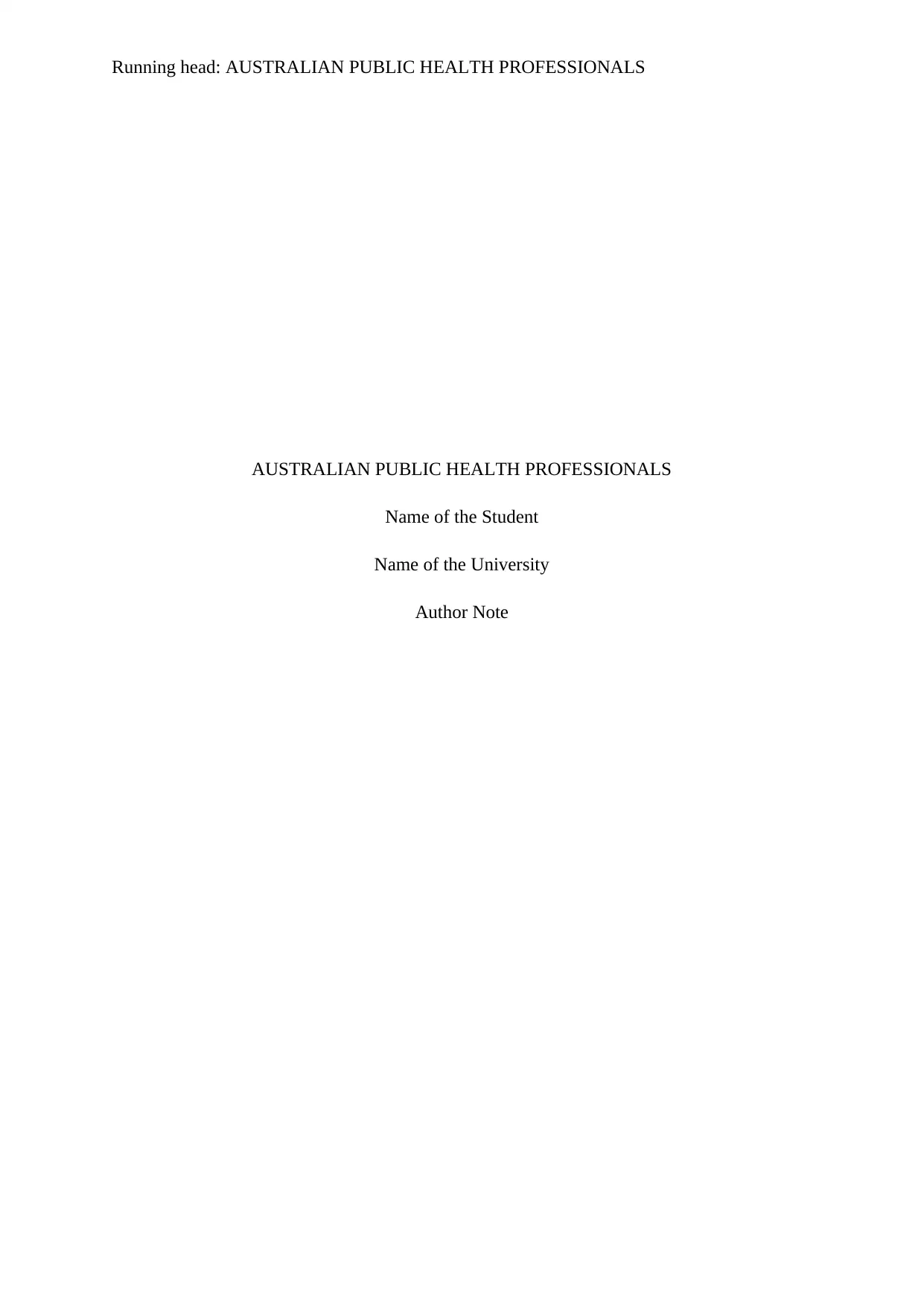
Running head: AUSTRALIAN PUBLIC HEALTH PROFESSIONALS
AUSTRALIAN PUBLIC HEALTH PROFESSIONALS
Name of the Student
Name of the University
Author Note
AUSTRALIAN PUBLIC HEALTH PROFESSIONALS
Name of the Student
Name of the University
Author Note
Paraphrase This Document
Need a fresh take? Get an instant paraphrase of this document with our AI Paraphraser
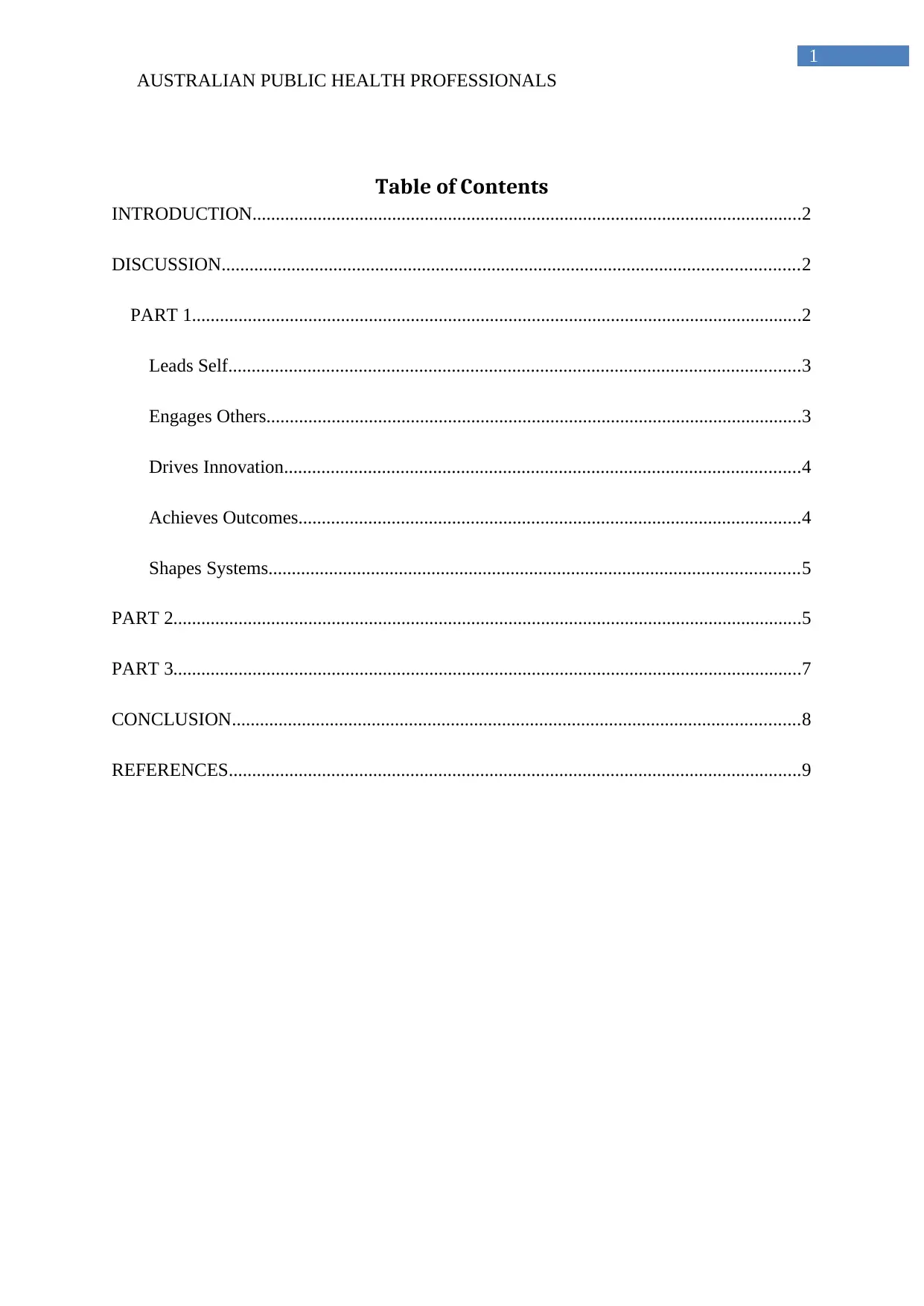
1
AUSTRALIAN PUBLIC HEALTH PROFESSIONALS
Table of Contents
INTRODUCTION......................................................................................................................2
DISCUSSION............................................................................................................................2
PART 1...................................................................................................................................2
Leads Self...........................................................................................................................3
Engages Others...................................................................................................................3
Drives Innovation...............................................................................................................4
Achieves Outcomes............................................................................................................4
Shapes Systems..................................................................................................................5
PART 2.......................................................................................................................................5
PART 3.......................................................................................................................................7
CONCLUSION..........................................................................................................................8
REFERENCES...........................................................................................................................9
AUSTRALIAN PUBLIC HEALTH PROFESSIONALS
Table of Contents
INTRODUCTION......................................................................................................................2
DISCUSSION............................................................................................................................2
PART 1...................................................................................................................................2
Leads Self...........................................................................................................................3
Engages Others...................................................................................................................3
Drives Innovation...............................................................................................................4
Achieves Outcomes............................................................................................................4
Shapes Systems..................................................................................................................5
PART 2.......................................................................................................................................5
PART 3.......................................................................................................................................7
CONCLUSION..........................................................................................................................8
REFERENCES...........................................................................................................................9
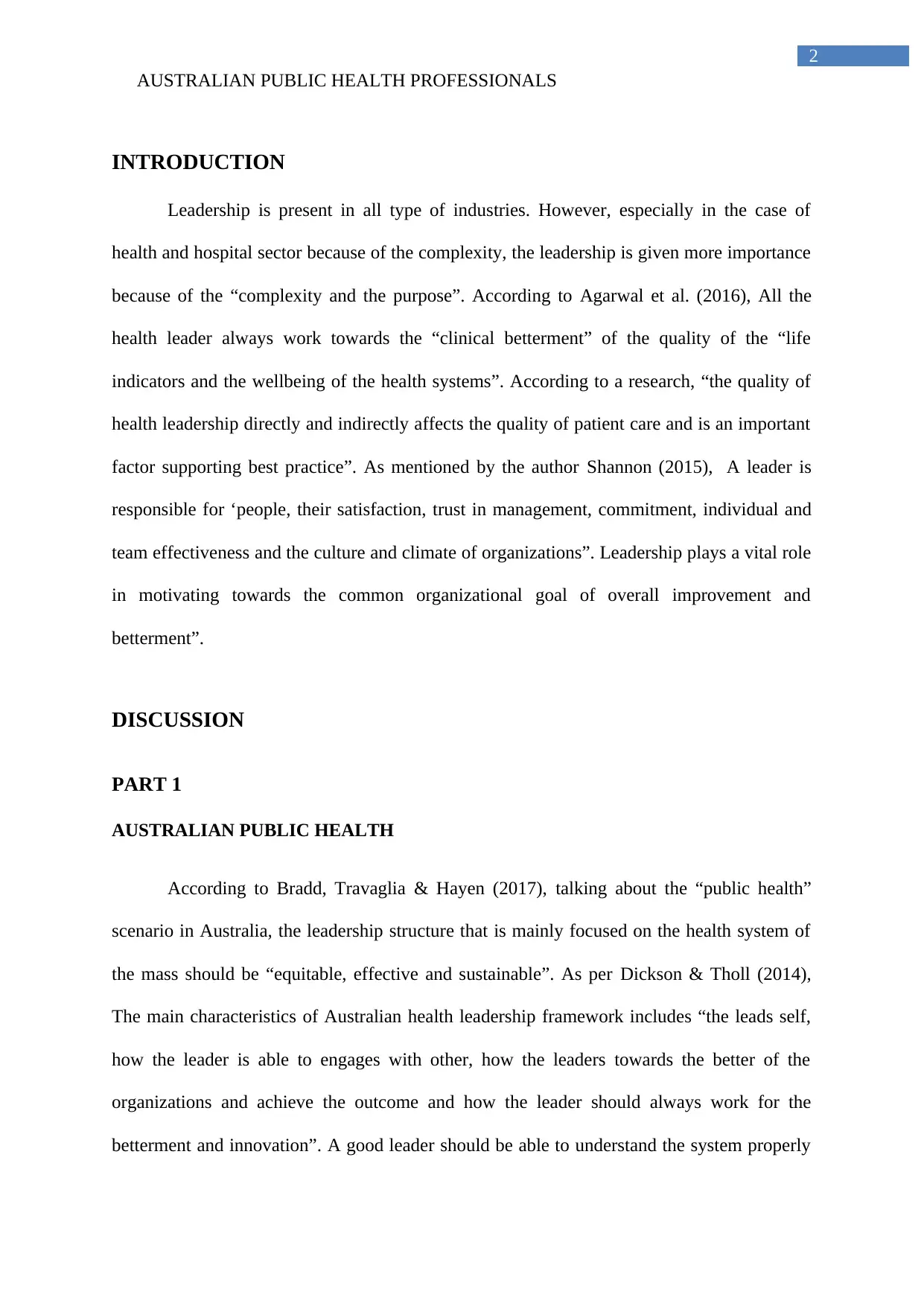
2
AUSTRALIAN PUBLIC HEALTH PROFESSIONALS
INTRODUCTION
Leadership is present in all type of industries. However, especially in the case of
health and hospital sector because of the complexity, the leadership is given more importance
because of the “complexity and the purpose”. According to Agarwal et al. (2016), All the
health leader always work towards the “clinical betterment” of the quality of the “life
indicators and the wellbeing of the health systems”. According to a research, “the quality of
health leadership directly and indirectly affects the quality of patient care and is an important
factor supporting best practice”. As mentioned by the author Shannon (2015), A leader is
responsible for ‘people, their satisfaction, trust in management, commitment, individual and
team effectiveness and the culture and climate of organizations”. Leadership plays a vital role
in motivating towards the common organizational goal of overall improvement and
betterment”.
DISCUSSION
PART 1
AUSTRALIAN PUBLIC HEALTH
According to Bradd, Travaglia & Hayen (2017), talking about the “public health”
scenario in Australia, the leadership structure that is mainly focused on the health system of
the mass should be “equitable, effective and sustainable”. As per Dickson & Tholl (2014),
The main characteristics of Australian health leadership framework includes “the leads self,
how the leader is able to engages with other, how the leaders towards the better of the
organizations and achieve the outcome and how the leader should always work for the
betterment and innovation”. A good leader should be able to understand the system properly
AUSTRALIAN PUBLIC HEALTH PROFESSIONALS
INTRODUCTION
Leadership is present in all type of industries. However, especially in the case of
health and hospital sector because of the complexity, the leadership is given more importance
because of the “complexity and the purpose”. According to Agarwal et al. (2016), All the
health leader always work towards the “clinical betterment” of the quality of the “life
indicators and the wellbeing of the health systems”. According to a research, “the quality of
health leadership directly and indirectly affects the quality of patient care and is an important
factor supporting best practice”. As mentioned by the author Shannon (2015), A leader is
responsible for ‘people, their satisfaction, trust in management, commitment, individual and
team effectiveness and the culture and climate of organizations”. Leadership plays a vital role
in motivating towards the common organizational goal of overall improvement and
betterment”.
DISCUSSION
PART 1
AUSTRALIAN PUBLIC HEALTH
According to Bradd, Travaglia & Hayen (2017), talking about the “public health”
scenario in Australia, the leadership structure that is mainly focused on the health system of
the mass should be “equitable, effective and sustainable”. As per Dickson & Tholl (2014),
The main characteristics of Australian health leadership framework includes “the leads self,
how the leader is able to engages with other, how the leaders towards the better of the
organizations and achieve the outcome and how the leader should always work for the
betterment and innovation”. A good leader should be able to understand the system properly
⊘ This is a preview!⊘
Do you want full access?
Subscribe today to unlock all pages.

Trusted by 1+ million students worldwide
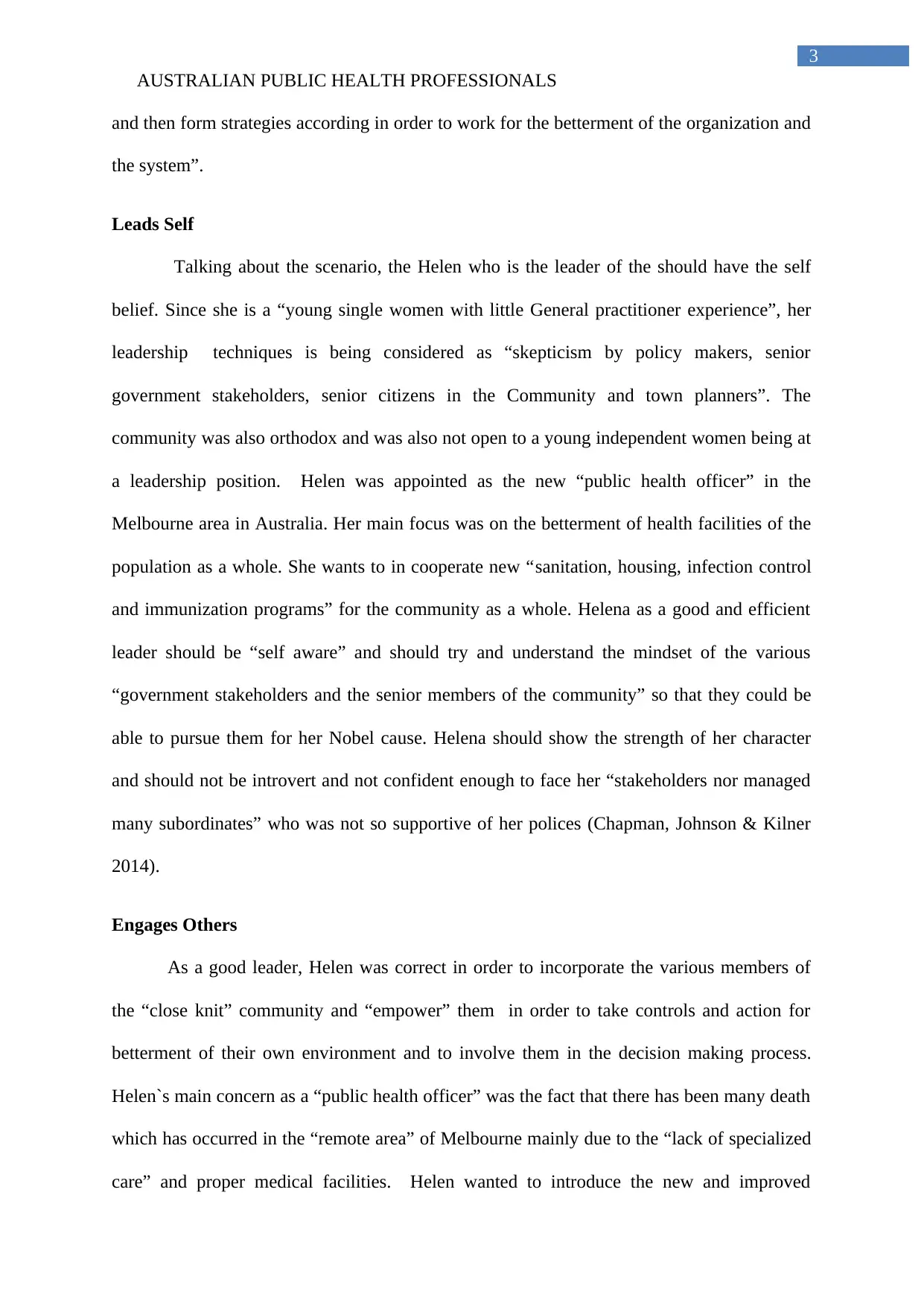
3
AUSTRALIAN PUBLIC HEALTH PROFESSIONALS
and then form strategies according in order to work for the betterment of the organization and
the system”.
Leads Self
Talking about the scenario, the Helen who is the leader of the should have the self
belief. Since she is a “young single women with little General practitioner experience”, her
leadership techniques is being considered as “skepticism by policy makers, senior
government stakeholders, senior citizens in the Community and town planners”. The
community was also orthodox and was also not open to a young independent women being at
a leadership position. Helen was appointed as the new “public health officer” in the
Melbourne area in Australia. Her main focus was on the betterment of health facilities of the
population as a whole. She wants to in cooperate new “sanitation, housing, infection control
and immunization programs” for the community as a whole. Helena as a good and efficient
leader should be “self aware” and should try and understand the mindset of the various
“government stakeholders and the senior members of the community” so that they could be
able to pursue them for her Nobel cause. Helena should show the strength of her character
and should not be introvert and not confident enough to face her “stakeholders nor managed
many subordinates” who was not so supportive of her polices (Chapman, Johnson & Kilner
2014).
Engages Others
As a good leader, Helen was correct in order to incorporate the various members of
the “close knit” community and “empower” them in order to take controls and action for
betterment of their own environment and to involve them in the decision making process.
Helen`s main concern as a “public health officer” was the fact that there has been many death
which has occurred in the “remote area” of Melbourne mainly due to the “lack of specialized
care” and proper medical facilities. Helen wanted to introduce the new and improved
AUSTRALIAN PUBLIC HEALTH PROFESSIONALS
and then form strategies according in order to work for the betterment of the organization and
the system”.
Leads Self
Talking about the scenario, the Helen who is the leader of the should have the self
belief. Since she is a “young single women with little General practitioner experience”, her
leadership techniques is being considered as “skepticism by policy makers, senior
government stakeholders, senior citizens in the Community and town planners”. The
community was also orthodox and was also not open to a young independent women being at
a leadership position. Helen was appointed as the new “public health officer” in the
Melbourne area in Australia. Her main focus was on the betterment of health facilities of the
population as a whole. She wants to in cooperate new “sanitation, housing, infection control
and immunization programs” for the community as a whole. Helena as a good and efficient
leader should be “self aware” and should try and understand the mindset of the various
“government stakeholders and the senior members of the community” so that they could be
able to pursue them for her Nobel cause. Helena should show the strength of her character
and should not be introvert and not confident enough to face her “stakeholders nor managed
many subordinates” who was not so supportive of her polices (Chapman, Johnson & Kilner
2014).
Engages Others
As a good leader, Helen was correct in order to incorporate the various members of
the “close knit” community and “empower” them in order to take controls and action for
betterment of their own environment and to involve them in the decision making process.
Helen`s main concern as a “public health officer” was the fact that there has been many death
which has occurred in the “remote area” of Melbourne mainly due to the “lack of specialized
care” and proper medical facilities. Helen wanted to introduce the new and improved
Paraphrase This Document
Need a fresh take? Get an instant paraphrase of this document with our AI Paraphraser
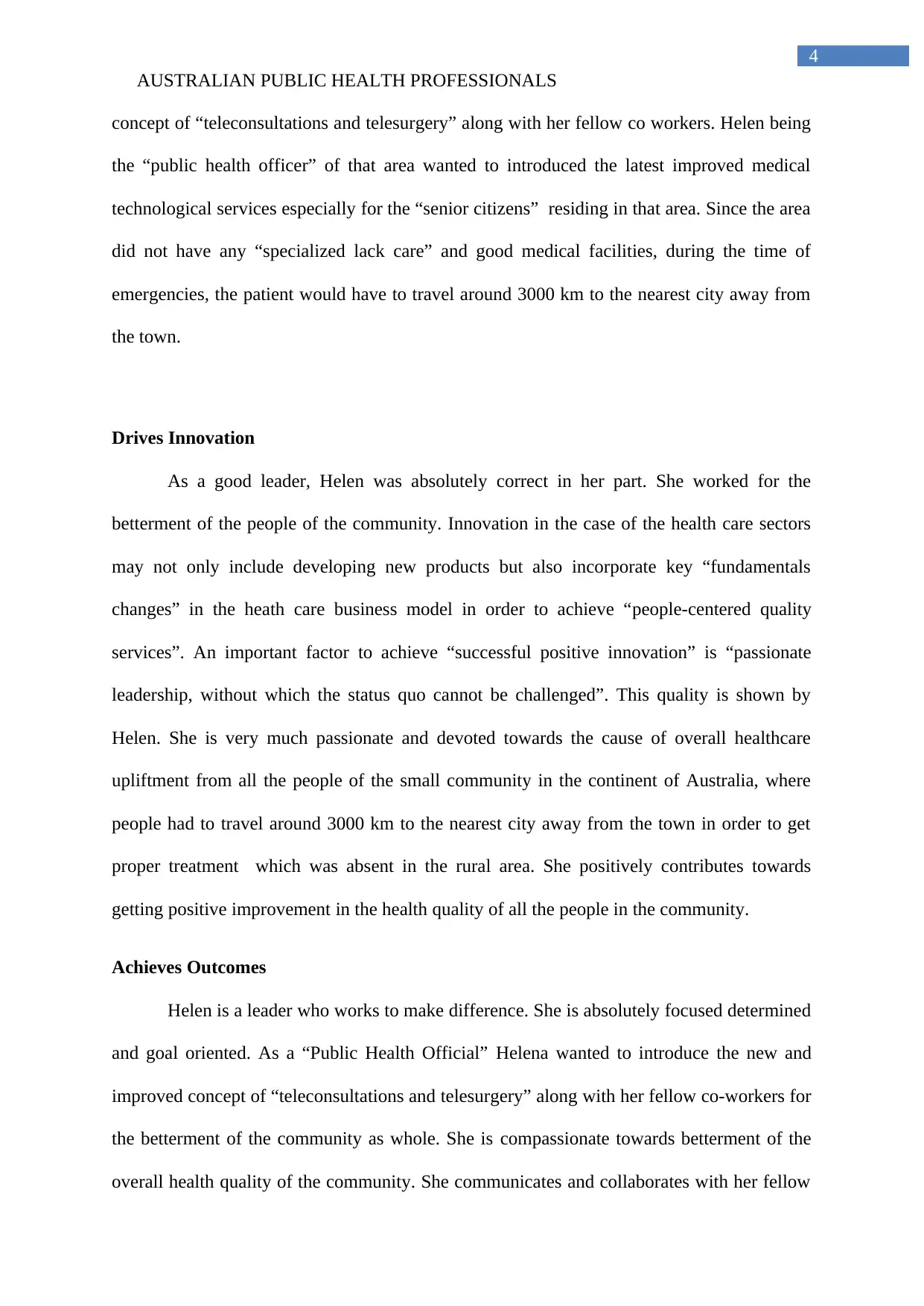
4
AUSTRALIAN PUBLIC HEALTH PROFESSIONALS
concept of “teleconsultations and telesurgery” along with her fellow co workers. Helen being
the “public health officer” of that area wanted to introduced the latest improved medical
technological services especially for the “senior citizens” residing in that area. Since the area
did not have any “specialized lack care” and good medical facilities, during the time of
emergencies, the patient would have to travel around 3000 km to the nearest city away from
the town.
Drives Innovation
As a good leader, Helen was absolutely correct in her part. She worked for the
betterment of the people of the community. Innovation in the case of the health care sectors
may not only include developing new products but also incorporate key “fundamentals
changes” in the heath care business model in order to achieve “people-centered quality
services”. An important factor to achieve “successful positive innovation” is “passionate
leadership, without which the status quo cannot be challenged”. This quality is shown by
Helen. She is very much passionate and devoted towards the cause of overall healthcare
upliftment from all the people of the small community in the continent of Australia, where
people had to travel around 3000 km to the nearest city away from the town in order to get
proper treatment which was absent in the rural area. She positively contributes towards
getting positive improvement in the health quality of all the people in the community.
Achieves Outcomes
Helen is a leader who works to make difference. She is absolutely focused determined
and goal oriented. As a “Public Health Official” Helena wanted to introduce the new and
improved concept of “teleconsultations and telesurgery” along with her fellow co-workers for
the betterment of the community as whole. She is compassionate towards betterment of the
overall health quality of the community. She communicates and collaborates with her fellow
AUSTRALIAN PUBLIC HEALTH PROFESSIONALS
concept of “teleconsultations and telesurgery” along with her fellow co workers. Helen being
the “public health officer” of that area wanted to introduced the latest improved medical
technological services especially for the “senior citizens” residing in that area. Since the area
did not have any “specialized lack care” and good medical facilities, during the time of
emergencies, the patient would have to travel around 3000 km to the nearest city away from
the town.
Drives Innovation
As a good leader, Helen was absolutely correct in her part. She worked for the
betterment of the people of the community. Innovation in the case of the health care sectors
may not only include developing new products but also incorporate key “fundamentals
changes” in the heath care business model in order to achieve “people-centered quality
services”. An important factor to achieve “successful positive innovation” is “passionate
leadership, without which the status quo cannot be challenged”. This quality is shown by
Helen. She is very much passionate and devoted towards the cause of overall healthcare
upliftment from all the people of the small community in the continent of Australia, where
people had to travel around 3000 km to the nearest city away from the town in order to get
proper treatment which was absent in the rural area. She positively contributes towards
getting positive improvement in the health quality of all the people in the community.
Achieves Outcomes
Helen is a leader who works to make difference. She is absolutely focused determined
and goal oriented. As a “Public Health Official” Helena wanted to introduce the new and
improved concept of “teleconsultations and telesurgery” along with her fellow co-workers for
the betterment of the community as whole. She is compassionate towards betterment of the
overall health quality of the community. She communicates and collaborates with her fellow
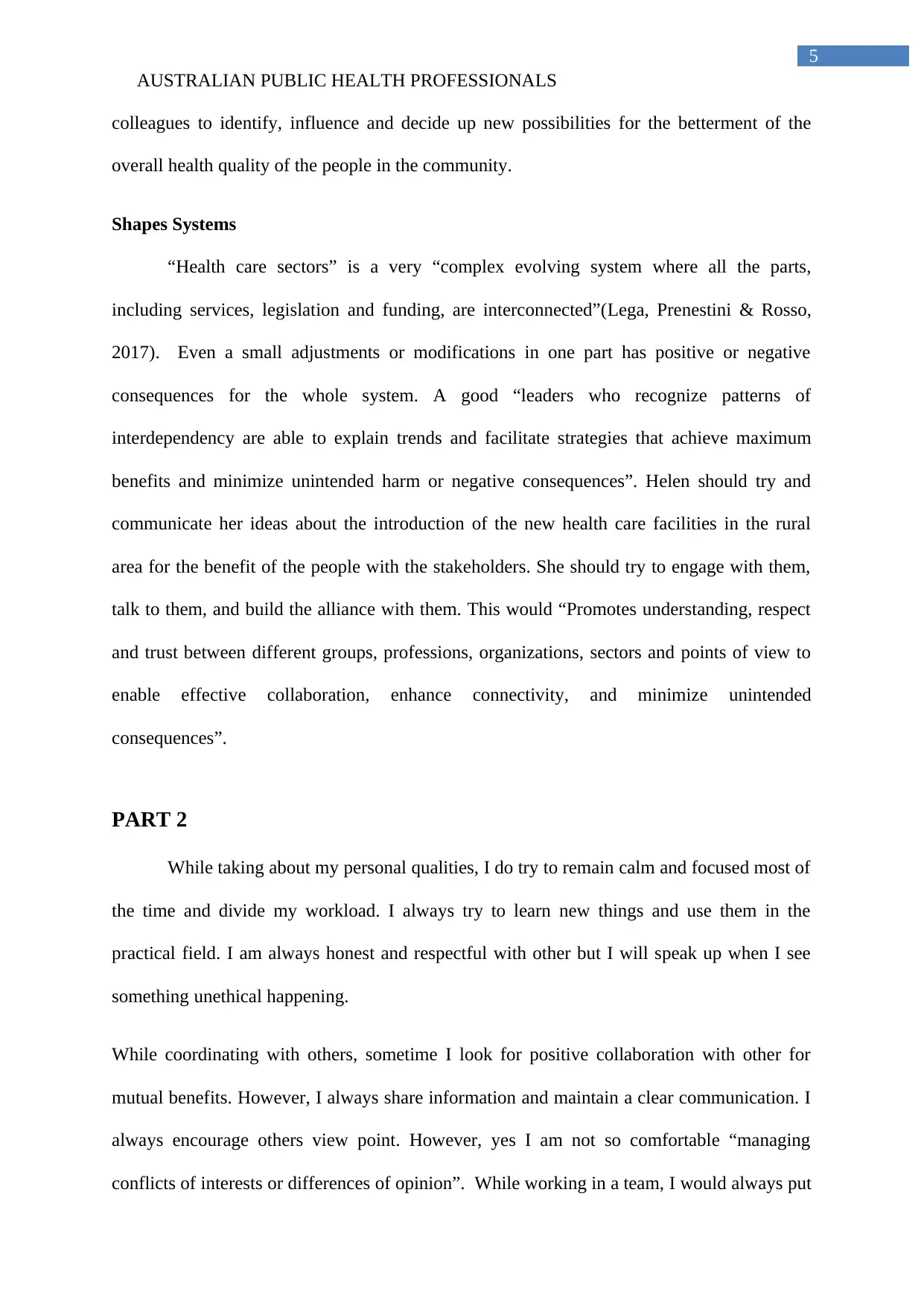
5
AUSTRALIAN PUBLIC HEALTH PROFESSIONALS
colleagues to identify, influence and decide up new possibilities for the betterment of the
overall health quality of the people in the community.
Shapes Systems
“Health care sectors” is a very “complex evolving system where all the parts,
including services, legislation and funding, are interconnected”(Lega, Prenestini & Rosso,
2017). Even a small adjustments or modifications in one part has positive or negative
consequences for the whole system. A good “leaders who recognize patterns of
interdependency are able to explain trends and facilitate strategies that achieve maximum
benefits and minimize unintended harm or negative consequences”. Helen should try and
communicate her ideas about the introduction of the new health care facilities in the rural
area for the benefit of the people with the stakeholders. She should try to engage with them,
talk to them, and build the alliance with them. This would “Promotes understanding, respect
and trust between different groups, professions, organizations, sectors and points of view to
enable effective collaboration, enhance connectivity, and minimize unintended
consequences”.
PART 2
While taking about my personal qualities, I do try to remain calm and focused most of
the time and divide my workload. I always try to learn new things and use them in the
practical field. I am always honest and respectful with other but I will speak up when I see
something unethical happening.
While coordinating with others, sometime I look for positive collaboration with other for
mutual benefits. However, I always share information and maintain a clear communication. I
always encourage others view point. However, yes I am not so comfortable “managing
conflicts of interests or differences of opinion”. While working in a team, I would always put
AUSTRALIAN PUBLIC HEALTH PROFESSIONALS
colleagues to identify, influence and decide up new possibilities for the betterment of the
overall health quality of the people in the community.
Shapes Systems
“Health care sectors” is a very “complex evolving system where all the parts,
including services, legislation and funding, are interconnected”(Lega, Prenestini & Rosso,
2017). Even a small adjustments or modifications in one part has positive or negative
consequences for the whole system. A good “leaders who recognize patterns of
interdependency are able to explain trends and facilitate strategies that achieve maximum
benefits and minimize unintended harm or negative consequences”. Helen should try and
communicate her ideas about the introduction of the new health care facilities in the rural
area for the benefit of the people with the stakeholders. She should try to engage with them,
talk to them, and build the alliance with them. This would “Promotes understanding, respect
and trust between different groups, professions, organizations, sectors and points of view to
enable effective collaboration, enhance connectivity, and minimize unintended
consequences”.
PART 2
While taking about my personal qualities, I do try to remain calm and focused most of
the time and divide my workload. I always try to learn new things and use them in the
practical field. I am always honest and respectful with other but I will speak up when I see
something unethical happening.
While coordinating with others, sometime I look for positive collaboration with other for
mutual benefits. However, I always share information and maintain a clear communication. I
always encourage others view point. However, yes I am not so comfortable “managing
conflicts of interests or differences of opinion”. While working in a team, I would always put
⊘ This is a preview!⊘
Do you want full access?
Subscribe today to unlock all pages.

Trusted by 1+ million students worldwide
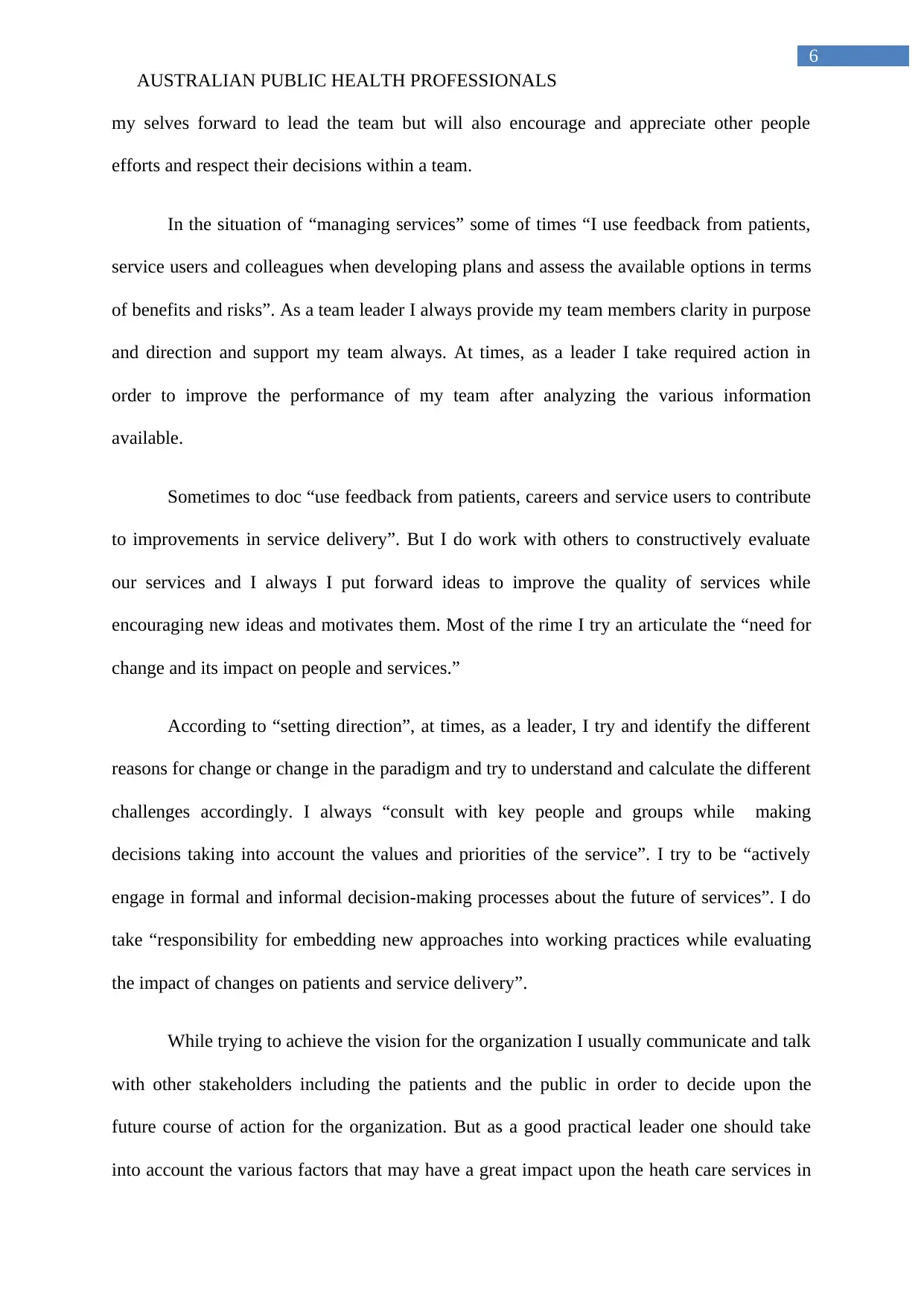
6
AUSTRALIAN PUBLIC HEALTH PROFESSIONALS
my selves forward to lead the team but will also encourage and appreciate other people
efforts and respect their decisions within a team.
In the situation of “managing services” some of times “I use feedback from patients,
service users and colleagues when developing plans and assess the available options in terms
of benefits and risks”. As a team leader I always provide my team members clarity in purpose
and direction and support my team always. At times, as a leader I take required action in
order to improve the performance of my team after analyzing the various information
available.
Sometimes to doc “use feedback from patients, careers and service users to contribute
to improvements in service delivery”. But I do work with others to constructively evaluate
our services and I always I put forward ideas to improve the quality of services while
encouraging new ideas and motivates them. Most of the rime I try an articulate the “need for
change and its impact on people and services.”
According to “setting direction”, at times, as a leader, I try and identify the different
reasons for change or change in the paradigm and try to understand and calculate the different
challenges accordingly. I always “consult with key people and groups while making
decisions taking into account the values and priorities of the service”. I try to be “actively
engage in formal and informal decision-making processes about the future of services”. I do
take “responsibility for embedding new approaches into working practices while evaluating
the impact of changes on patients and service delivery”.
While trying to achieve the vision for the organization I usually communicate and talk
with other stakeholders including the patients and the public in order to decide upon the
future course of action for the organization. But as a good practical leader one should take
into account the various factors that may have a great impact upon the heath care services in
AUSTRALIAN PUBLIC HEALTH PROFESSIONALS
my selves forward to lead the team but will also encourage and appreciate other people
efforts and respect their decisions within a team.
In the situation of “managing services” some of times “I use feedback from patients,
service users and colleagues when developing plans and assess the available options in terms
of benefits and risks”. As a team leader I always provide my team members clarity in purpose
and direction and support my team always. At times, as a leader I take required action in
order to improve the performance of my team after analyzing the various information
available.
Sometimes to doc “use feedback from patients, careers and service users to contribute
to improvements in service delivery”. But I do work with others to constructively evaluate
our services and I always I put forward ideas to improve the quality of services while
encouraging new ideas and motivates them. Most of the rime I try an articulate the “need for
change and its impact on people and services.”
According to “setting direction”, at times, as a leader, I try and identify the different
reasons for change or change in the paradigm and try to understand and calculate the different
challenges accordingly. I always “consult with key people and groups while making
decisions taking into account the values and priorities of the service”. I try to be “actively
engage in formal and informal decision-making processes about the future of services”. I do
take “responsibility for embedding new approaches into working practices while evaluating
the impact of changes on patients and service delivery”.
While trying to achieve the vision for the organization I usually communicate and talk
with other stakeholders including the patients and the public in order to decide upon the
future course of action for the organization. But as a good practical leader one should take
into account the various factors that may have a great impact upon the heath care services in
Paraphrase This Document
Need a fresh take? Get an instant paraphrase of this document with our AI Paraphraser
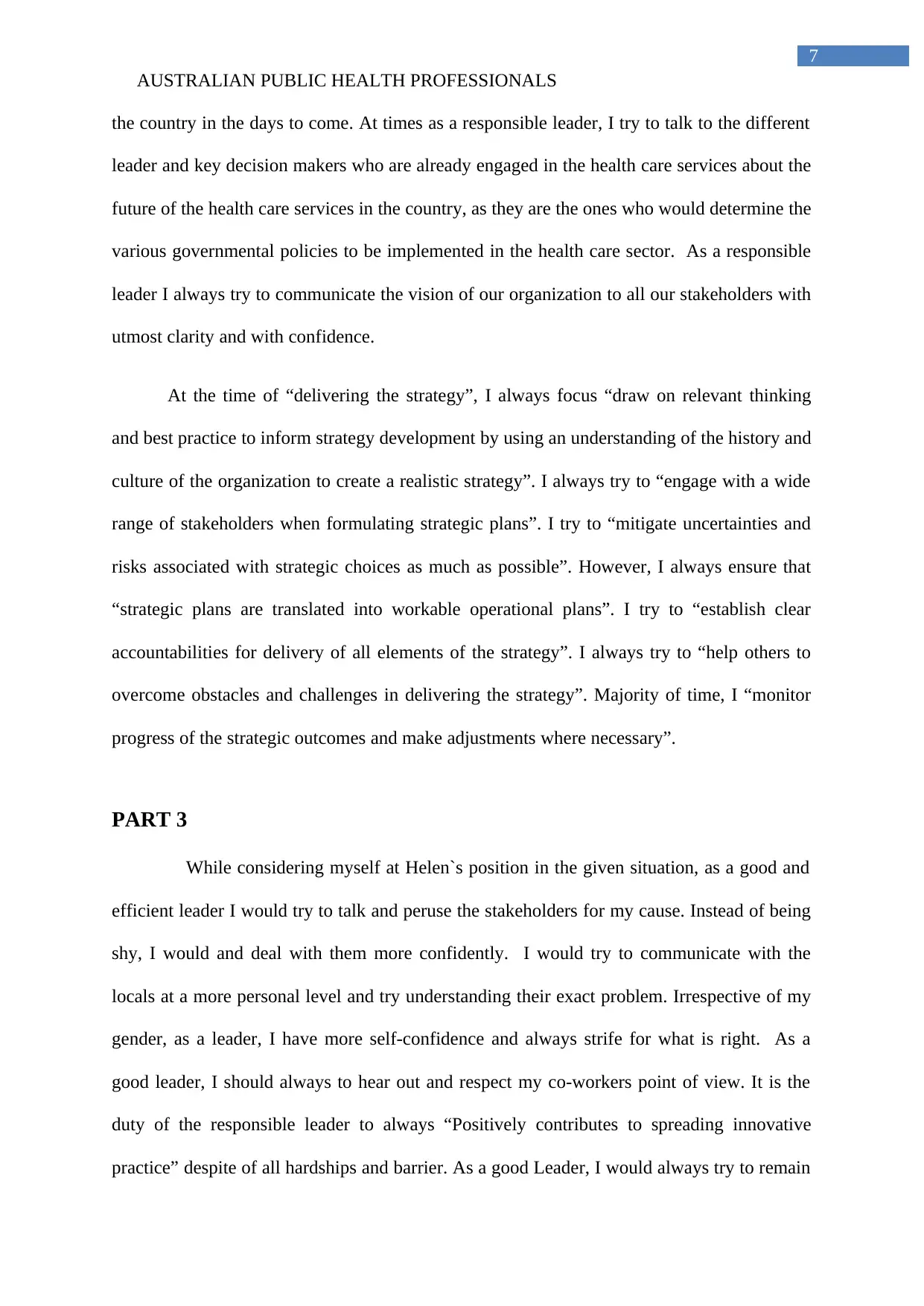
7
AUSTRALIAN PUBLIC HEALTH PROFESSIONALS
the country in the days to come. At times as a responsible leader, I try to talk to the different
leader and key decision makers who are already engaged in the health care services about the
future of the health care services in the country, as they are the ones who would determine the
various governmental policies to be implemented in the health care sector. As a responsible
leader I always try to communicate the vision of our organization to all our stakeholders with
utmost clarity and with confidence.
At the time of “delivering the strategy”, I always focus “draw on relevant thinking
and best practice to inform strategy development by using an understanding of the history and
culture of the organization to create a realistic strategy”. I always try to “engage with a wide
range of stakeholders when formulating strategic plans”. I try to “mitigate uncertainties and
risks associated with strategic choices as much as possible”. However, I always ensure that
“strategic plans are translated into workable operational plans”. I try to “establish clear
accountabilities for delivery of all elements of the strategy”. I always try to “help others to
overcome obstacles and challenges in delivering the strategy”. Majority of time, I “monitor
progress of the strategic outcomes and make adjustments where necessary”.
PART 3
While considering myself at Helen`s position in the given situation, as a good and
efficient leader I would try to talk and peruse the stakeholders for my cause. Instead of being
shy, I would and deal with them more confidently. I would try to communicate with the
locals at a more personal level and try understanding their exact problem. Irrespective of my
gender, as a leader, I have more self-confidence and always strife for what is right. As a
good leader, I should always to hear out and respect my co-workers point of view. It is the
duty of the responsible leader to always “Positively contributes to spreading innovative
practice” despite of all hardships and barrier. As a good Leader, I would always try to remain
AUSTRALIAN PUBLIC HEALTH PROFESSIONALS
the country in the days to come. At times as a responsible leader, I try to talk to the different
leader and key decision makers who are already engaged in the health care services about the
future of the health care services in the country, as they are the ones who would determine the
various governmental policies to be implemented in the health care sector. As a responsible
leader I always try to communicate the vision of our organization to all our stakeholders with
utmost clarity and with confidence.
At the time of “delivering the strategy”, I always focus “draw on relevant thinking
and best practice to inform strategy development by using an understanding of the history and
culture of the organization to create a realistic strategy”. I always try to “engage with a wide
range of stakeholders when formulating strategic plans”. I try to “mitigate uncertainties and
risks associated with strategic choices as much as possible”. However, I always ensure that
“strategic plans are translated into workable operational plans”. I try to “establish clear
accountabilities for delivery of all elements of the strategy”. I always try to “help others to
overcome obstacles and challenges in delivering the strategy”. Majority of time, I “monitor
progress of the strategic outcomes and make adjustments where necessary”.
PART 3
While considering myself at Helen`s position in the given situation, as a good and
efficient leader I would try to talk and peruse the stakeholders for my cause. Instead of being
shy, I would and deal with them more confidently. I would try to communicate with the
locals at a more personal level and try understanding their exact problem. Irrespective of my
gender, as a leader, I have more self-confidence and always strife for what is right. As a
good leader, I should always to hear out and respect my co-workers point of view. It is the
duty of the responsible leader to always “Positively contributes to spreading innovative
practice” despite of all hardships and barrier. As a good Leader, I would always try to remain
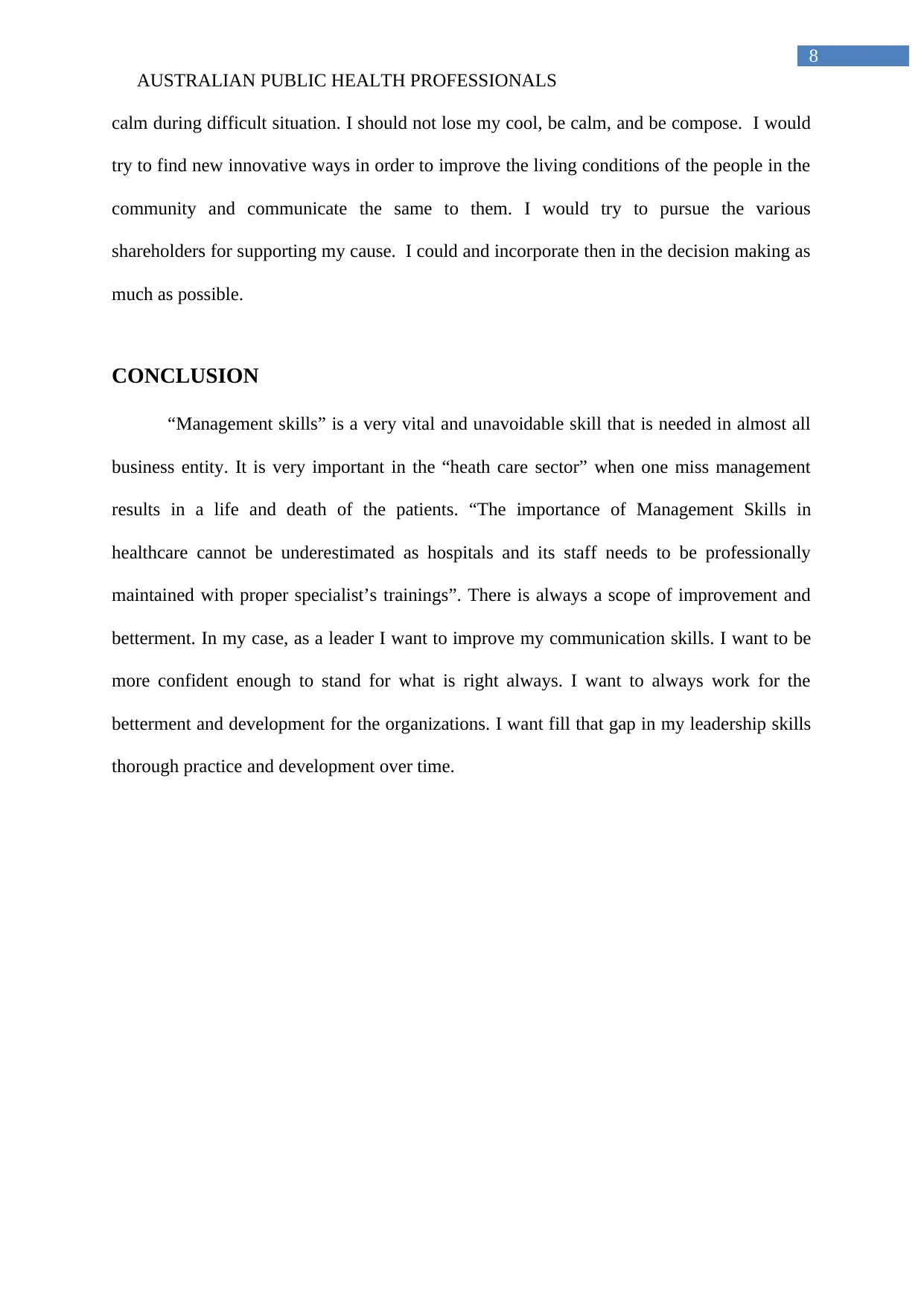
8
AUSTRALIAN PUBLIC HEALTH PROFESSIONALS
calm during difficult situation. I should not lose my cool, be calm, and be compose. I would
try to find new innovative ways in order to improve the living conditions of the people in the
community and communicate the same to them. I would try to pursue the various
shareholders for supporting my cause. I could and incorporate then in the decision making as
much as possible.
CONCLUSION
“Management skills” is a very vital and unavoidable skill that is needed in almost all
business entity. It is very important in the “heath care sector” when one miss management
results in a life and death of the patients. “The importance of Management Skills in
healthcare cannot be underestimated as hospitals and its staff needs to be professionally
maintained with proper specialist’s trainings”. There is always a scope of improvement and
betterment. In my case, as a leader I want to improve my communication skills. I want to be
more confident enough to stand for what is right always. I want to always work for the
betterment and development for the organizations. I want fill that gap in my leadership skills
thorough practice and development over time.
AUSTRALIAN PUBLIC HEALTH PROFESSIONALS
calm during difficult situation. I should not lose my cool, be calm, and be compose. I would
try to find new innovative ways in order to improve the living conditions of the people in the
community and communicate the same to them. I would try to pursue the various
shareholders for supporting my cause. I could and incorporate then in the decision making as
much as possible.
CONCLUSION
“Management skills” is a very vital and unavoidable skill that is needed in almost all
business entity. It is very important in the “heath care sector” when one miss management
results in a life and death of the patients. “The importance of Management Skills in
healthcare cannot be underestimated as hospitals and its staff needs to be professionally
maintained with proper specialist’s trainings”. There is always a scope of improvement and
betterment. In my case, as a leader I want to improve my communication skills. I want to be
more confident enough to stand for what is right always. I want to always work for the
betterment and development for the organizations. I want fill that gap in my leadership skills
thorough practice and development over time.
⊘ This is a preview!⊘
Do you want full access?
Subscribe today to unlock all pages.

Trusted by 1+ million students worldwide
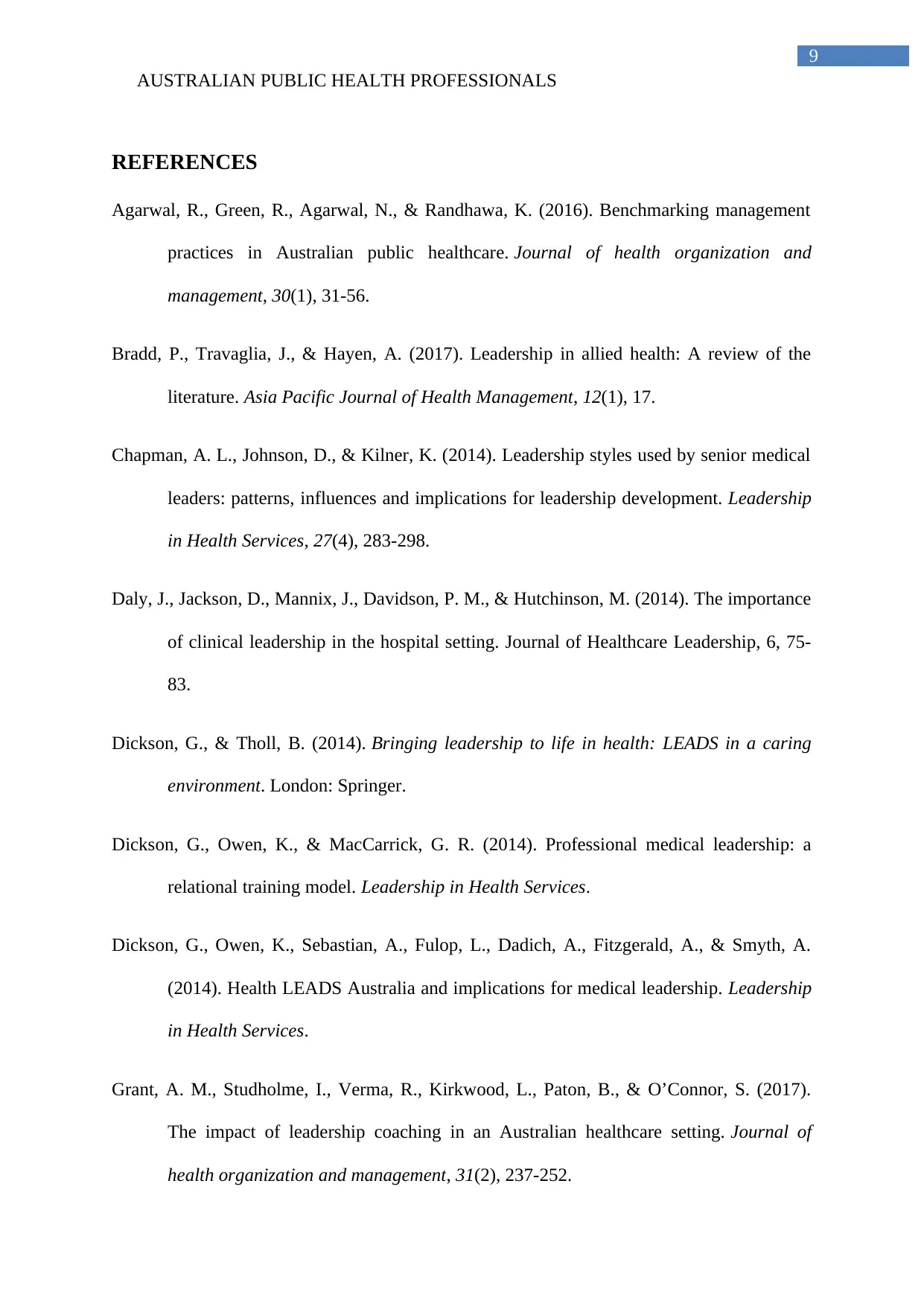
9
AUSTRALIAN PUBLIC HEALTH PROFESSIONALS
REFERENCES
Agarwal, R., Green, R., Agarwal, N., & Randhawa, K. (2016). Benchmarking management
practices in Australian public healthcare. Journal of health organization and
management, 30(1), 31-56.
Bradd, P., Travaglia, J., & Hayen, A. (2017). Leadership in allied health: A review of the
literature. Asia Pacific Journal of Health Management, 12(1), 17.
Chapman, A. L., Johnson, D., & Kilner, K. (2014). Leadership styles used by senior medical
leaders: patterns, influences and implications for leadership development. Leadership
in Health Services, 27(4), 283-298.
Daly, J., Jackson, D., Mannix, J., Davidson, P. M., & Hutchinson, M. (2014). The importance
of clinical leadership in the hospital setting. Journal of Healthcare Leadership, 6, 75-
83.
Dickson, G., & Tholl, B. (2014). Bringing leadership to life in health: LEADS in a caring
environment. London: Springer.
Dickson, G., Owen, K., & MacCarrick, G. R. (2014). Professional medical leadership: a
relational training model. Leadership in Health Services.
Dickson, G., Owen, K., Sebastian, A., Fulop, L., Dadich, A., Fitzgerald, A., & Smyth, A.
(2014). Health LEADS Australia and implications for medical leadership. Leadership
in Health Services.
Grant, A. M., Studholme, I., Verma, R., Kirkwood, L., Paton, B., & O’Connor, S. (2017).
The impact of leadership coaching in an Australian healthcare setting. Journal of
health organization and management, 31(2), 237-252.
AUSTRALIAN PUBLIC HEALTH PROFESSIONALS
REFERENCES
Agarwal, R., Green, R., Agarwal, N., & Randhawa, K. (2016). Benchmarking management
practices in Australian public healthcare. Journal of health organization and
management, 30(1), 31-56.
Bradd, P., Travaglia, J., & Hayen, A. (2017). Leadership in allied health: A review of the
literature. Asia Pacific Journal of Health Management, 12(1), 17.
Chapman, A. L., Johnson, D., & Kilner, K. (2014). Leadership styles used by senior medical
leaders: patterns, influences and implications for leadership development. Leadership
in Health Services, 27(4), 283-298.
Daly, J., Jackson, D., Mannix, J., Davidson, P. M., & Hutchinson, M. (2014). The importance
of clinical leadership in the hospital setting. Journal of Healthcare Leadership, 6, 75-
83.
Dickson, G., & Tholl, B. (2014). Bringing leadership to life in health: LEADS in a caring
environment. London: Springer.
Dickson, G., Owen, K., & MacCarrick, G. R. (2014). Professional medical leadership: a
relational training model. Leadership in Health Services.
Dickson, G., Owen, K., Sebastian, A., Fulop, L., Dadich, A., Fitzgerald, A., & Smyth, A.
(2014). Health LEADS Australia and implications for medical leadership. Leadership
in Health Services.
Grant, A. M., Studholme, I., Verma, R., Kirkwood, L., Paton, B., & O’Connor, S. (2017).
The impact of leadership coaching in an Australian healthcare setting. Journal of
health organization and management, 31(2), 237-252.
Paraphrase This Document
Need a fresh take? Get an instant paraphrase of this document with our AI Paraphraser
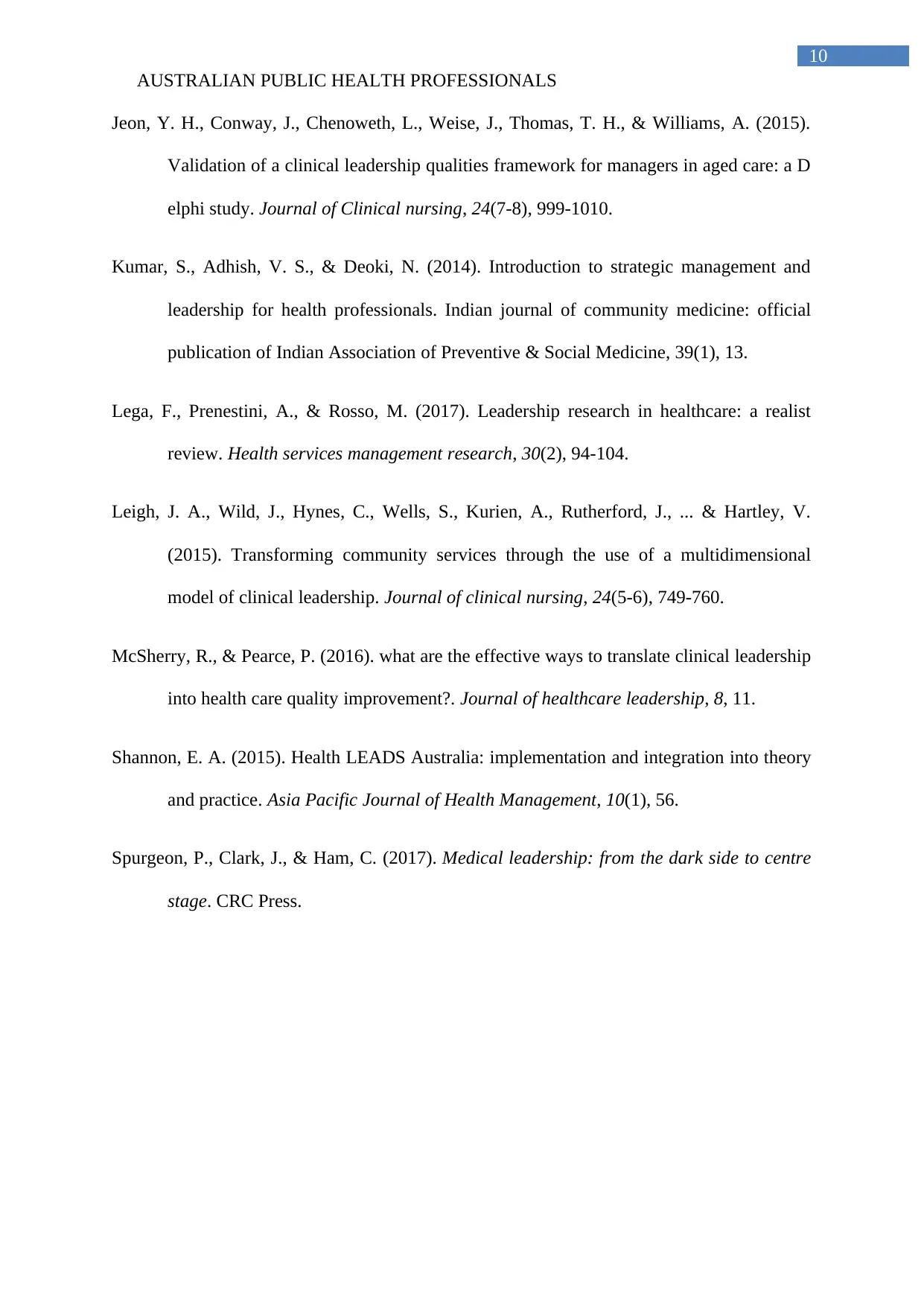
10
AUSTRALIAN PUBLIC HEALTH PROFESSIONALS
Jeon, Y. H., Conway, J., Chenoweth, L., Weise, J., Thomas, T. H., & Williams, A. (2015).
Validation of a clinical leadership qualities framework for managers in aged care: a D
elphi study. Journal of Clinical nursing, 24(7-8), 999-1010.
Kumar, S., Adhish, V. S., & Deoki, N. (2014). Introduction to strategic management and
leadership for health professionals. Indian journal of community medicine: official
publication of Indian Association of Preventive & Social Medicine, 39(1), 13.
Lega, F., Prenestini, A., & Rosso, M. (2017). Leadership research in healthcare: a realist
review. Health services management research, 30(2), 94-104.
Leigh, J. A., Wild, J., Hynes, C., Wells, S., Kurien, A., Rutherford, J., ... & Hartley, V.
(2015). Transforming community services through the use of a multidimensional
model of clinical leadership. Journal of clinical nursing, 24(5-6), 749-760.
McSherry, R., & Pearce, P. (2016). what are the effective ways to translate clinical leadership
into health care quality improvement?. Journal of healthcare leadership, 8, 11.
Shannon, E. A. (2015). Health LEADS Australia: implementation and integration into theory
and practice. Asia Pacific Journal of Health Management, 10(1), 56.
Spurgeon, P., Clark, J., & Ham, C. (2017). Medical leadership: from the dark side to centre
stage. CRC Press.
AUSTRALIAN PUBLIC HEALTH PROFESSIONALS
Jeon, Y. H., Conway, J., Chenoweth, L., Weise, J., Thomas, T. H., & Williams, A. (2015).
Validation of a clinical leadership qualities framework for managers in aged care: a D
elphi study. Journal of Clinical nursing, 24(7-8), 999-1010.
Kumar, S., Adhish, V. S., & Deoki, N. (2014). Introduction to strategic management and
leadership for health professionals. Indian journal of community medicine: official
publication of Indian Association of Preventive & Social Medicine, 39(1), 13.
Lega, F., Prenestini, A., & Rosso, M. (2017). Leadership research in healthcare: a realist
review. Health services management research, 30(2), 94-104.
Leigh, J. A., Wild, J., Hynes, C., Wells, S., Kurien, A., Rutherford, J., ... & Hartley, V.
(2015). Transforming community services through the use of a multidimensional
model of clinical leadership. Journal of clinical nursing, 24(5-6), 749-760.
McSherry, R., & Pearce, P. (2016). what are the effective ways to translate clinical leadership
into health care quality improvement?. Journal of healthcare leadership, 8, 11.
Shannon, E. A. (2015). Health LEADS Australia: implementation and integration into theory
and practice. Asia Pacific Journal of Health Management, 10(1), 56.
Spurgeon, P., Clark, J., & Ham, C. (2017). Medical leadership: from the dark side to centre
stage. CRC Press.
1 out of 11
Related Documents
Your All-in-One AI-Powered Toolkit for Academic Success.
+13062052269
info@desklib.com
Available 24*7 on WhatsApp / Email
![[object Object]](/_next/static/media/star-bottom.7253800d.svg)
Unlock your academic potential
Copyright © 2020–2025 A2Z Services. All Rights Reserved. Developed and managed by ZUCOL.





